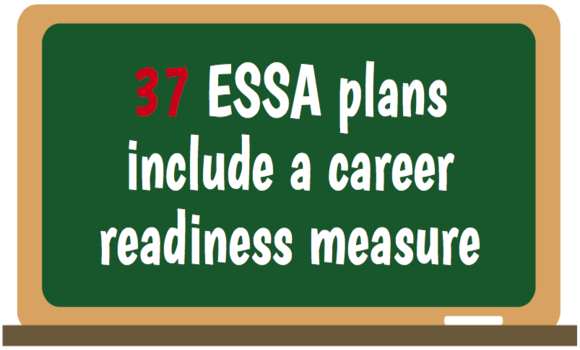States on the Path to Destination Known

Career readiness is now significantly more meaningful for thousands of schools—and students—across the country. Thirty-seven of the 51 state Every Student Succeeds Act (ESSA) accountability plans include some measure of career readiness, and an additional four states are planning to include a measure in the near future. Altogether, this is more than double the 20 states that included a measure prior to ESSA. This is a watershed moment for K-12 schools that should be celebrated, and yet much work remains to ensure that career readiness does not remain the silent partner in college and career readiness.
In early 2017, Education Strategy Group, in partnership with CCSSO, released a set of recommended college- and career-ready measures for states to include in their ESSA plans. Destination Known: Valuing College and Career Readiness in State Accountability Systems encouraged states to measure: (1) progress toward a post-high school credential, (2) co-curricular learning and leadership experiences, (3) assessment of readiness, and (4) transitions beyond high school. The report also laid out three concrete steps that states could take to hold schools accountable for these measures.
In our review of the first-round ESSA plans, 11 of the 17 included a career-ready metric and another three indicated plans to do so in the future. Of the 34 state plans submitted in Round 2, 26 addressed career readiness using one aspect of the recommended measures in their proposed accountability systems[1]. The best of those examples focused on (1) measuring student outcomes, (2) accounting for multiple aspects of student readiness, and (3) ensuring that the measures selected are the most predictive of postsecondary success. Examples from promising Round 2 plans are detailed below.
Align K-12 and Higher Education Goals
ESSA provided a perfect window for K-12 and higher education leaders to collaborate in establishing K-12 goals that will set the state on a path to meeting its postsecondary attainment goals. Oklahoma capitalized on this opportunity to ensure all system actors are rowing in the same direction. Oklahoma included two goals in ESSA to set the state on a path to meet its 70 by 25 attainment goal: (1) reduce by 50% the need for remediation after high school in each content area and (2) ensure that 100% of students develop a useful and meaningful Individual Academic Career plan that engages students and families to develop a clear and workable pathway to postsecondary success.
Make College- and Career-Ready Measures Count
To truly put college and career readiness at the forefront of the K-12 system, schools need to be held accountable for how well they are preparing students for the next steps beyond high school. In Round 2 plans, states proposed their college- and career-ready measures count for between 5 and 30% of a high school’s overall rating. In South Dakota, 25% of a high school’s rating will be based on the percent of graduates that (1) demonstrated progress toward a post-high school credential and (2) met readiness assessment qualifications. Progress toward a credential includes dual enrollment, CTE concentration, and capstone experiences, among others. Assessment of readiness includes scoring at the college- and career-ready level on Smarter Balanced, ACT or SAT, career readiness certificate or completion of a 12th grade transition course. Wyoming will use an indicator that measures the percent of graduates that complete a college- and career-ready course of study plus meet college and career benchmarks like earning an industry-recognized credential.
Highlight College- and Career-Ready Measures in Public Reporting
Every state has mechanisms in place today for publicly reporting how its schools are performing, including school report cards that give parents and community leaders critical information on how each school performs on a common set of indicators. Beyond holding schools directly accountable for performance, public transparency is a critical component to highlight gaps in access and success that must be addressed. South Carolina will measure the percent of students “Prepared for Success” using a number of different measures, such as college readiness benchmarks on the ACT and SAT, completion of a registered apprenticeship, and state-recognized industry credentials. Rather than simply rolling all of the measures up into a “metaindicator,” the state will report out the percentage of students that meet benchmarks for college-ready, career-ready, and college- and career-ready.
Planning is the easy part. The real work must now begin in states to bring these measures to life, ensuring that students have access to and can be successful in the courses, assessments, and experiences that demonstrate their readiness to succeed in the future. From defining lists of approved industry-recognized credentials to developing rubrics to measure skills gained in work-based learning to establishing data quality mechanisms, states need to double down on quality through implementation of their ESSA plans. And we must not become complacent with the measures identified today. States must continue to evolve their systems to incorporate new and higher-quality measures that focus on student outcomes, and track data over time to ensure that our notions of preparation ultimately pay off in terms of student success in postsecondary education and careers.
The path to preparing all students for success in their destinations beyond high school remains long. Luckily it’s now a little more crowded.
[1] Note that an additional 3 states submitting Round 2 plans indicated that they either (1) intend to add a career measure as soon as data are available or (2) have a separate state accountability system that incorporates a career-ready measure, bringing the total to 43 states in the near future.


